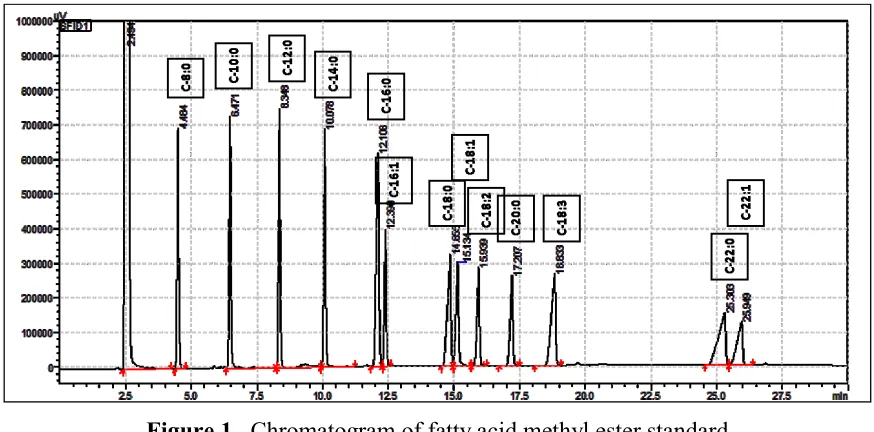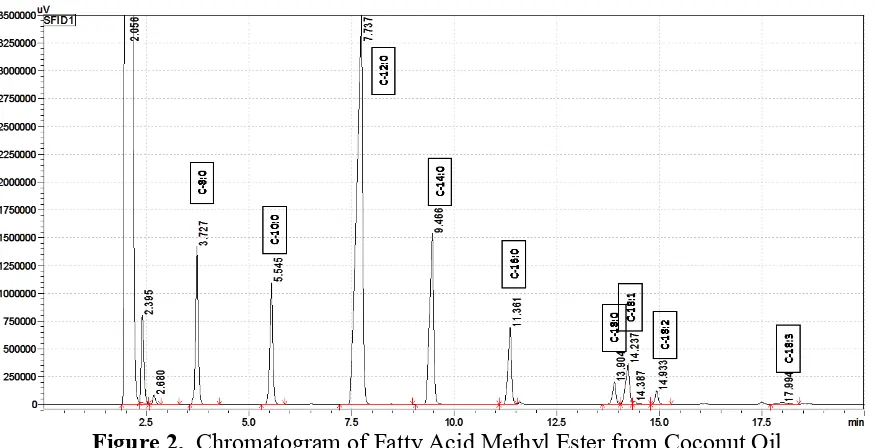The journal homepage www.jpacr.ub.ac.id p-ISSN : 2302 – 4690 | e-ISSN : 2541 – 0733
Gas Chromatographic Analysis of Medium Chain Fatty Acids in
Coconut Oil
Julius Pontoh1,*
1
Department of Chemistry, Sam Ratulangi University, Manado, Indonesia
*
Corresponding email : [email protected]
Received 9 May 2016; Revised 9 September 2016; Accepted 30 September 2016
ABSTRACT
Analysis of medium chain of fatty acids in coconut oil becomes important due to their roles in health issues. The present analysis methods for fatty acids present in food mainly focused to the overall fatty acid concentration. The analytical method for specific medium chain fatty acids was not so much be given attention. This research was focused to the analytical methods for these particular fatty acids in coconut oil. Several analytical methods were compared including acid catalyzed, basic catalyzed and acid boron trifluoride catalyzed derivatization. The response of each fatty acid toward the derivatization methods was different. Formation of the fatty acid methyl ester from caprylic and capric was low for acid catalyzed method compared to basic catalyzed method and acid boron trifluoride catalyzed methods. This result showed that the kinetics of the esterification among the fatty acids were not the same. The analysis of all fatty acids in coconut oil is better using basic catalyzed than the other methods.
Key Words : MCFA, coconut oil, Gas Chromatography, fatty acid analysis
INTRODUCTION
Coconut oil is one of the main agriculture products in Indonesia. The product got popularity recently after the roles of the medium chain fatty acids have been revealed. Medium chain fatty acids are known having a significant role in human metabolism as antibiotics, especially as antiviral and source of fast energy without disturbing the blood sugar in the body [1].
Coconut oil contains a significant amount (up to 50 percent) of lauric acid other than caprylic and capric acid [2]. These fatty acids brought the coconut oil product such as virgin coconut oil became a very popular product. It is related to the ability of the human body to overcome the vascular diseases and diabetic diseases. Medium chain fatty acids are known able to prevent wound in the artery surface by acting as antimicrobial and to supply energy for metabolism without increase the blood sugar level in mammals [3, 4].
The methods for analyzing the medium chain fatty acids in coconut oil are not studied so well yet up to date. So far the reported methods for fatty acid analysis in coconut are mostly based on the standard methods for fatty acid analysis. On the other hand, it is known that those medium chain fatty acids are more easily to be evaporated during derivatization so it is very important to be taking care during the derivatization.
by International of Union Pure and Applied Chemistry [5, 7, 8]. This method is claimed to be fast and efficiently and recommended by American Oil Chemists Society [9]. Nevertheless, Christie [5] pointed out that there are several drawbacks of this boron trifluoride method suffer from the reagent is very unstable for storage.
Gas chromatographic analysis of coconut oil has been reported for various purposes using various derivatization methods including base catalyzation [10], acid catalyzation [11] and acid trifluoride catalyzation [12], but no one give special attention on the derivatization methods. There is no report on the medium fatty acid derivatization including their kinetic of reaction and the efficiency compared to derivatization of other longer fatty acids. The main purposes of this work are to study the best method for determination of medium chain of fatty acids in coconut oil.
EXPERIMENT Materials
The coconut oils were purchased from the local markets. Sodium hydroxide, sulfuric acid, methanol, hexane, sodium chloride (NaCl), hydrochloric acid (HCl) and acetic acid, and sodium sulfate were purchased from BDH as analytical grade. The boron trifluoride methanol solution (15%) and standard fame mix C8-C24 were purchased from Sigma/Supelco.
Derivatization Methods
Acid catalyzed derivatization method [5]
50 mg of an aliquot sample was weighed in each of two screwed cap test tubes (10 mL) and was added 400 L of 1% methanolic H2SO4. The mixtures were heated at 50 oC for 2
and 4 hours respectively. After cooled, 1 mL of 15% NaCl was added, and then 1 mL hexane was added successively. The mixtures were vortex then settled for couple of minutes. The mixture formed two layers. The top layer was collected for further gas chromatographic analysis.
Base catalyzed derivatization method [5]
50 mg of an aliquot sample was weighed in a screwed cap test tubes (10 mL) and was added 400 uL of 0.5 M methanolic NaOH. The mixture then heated at 50 oC for 20 seconds. Then the mixture was added 1 mL of hexane and mixed utilizing vortex for 30 seconds. After settled, two layers will be formed. The top layer was transferred into a clean tube, was added 400 mL of 2 N methanolic HCl, and then mixed utilizing vortex. After it was settled for couple minutes, the top layer was removed and for further analyzed by gas chromatographic.
Boron trifluoride catalyzed derivatization method [13]
50 mg of an aliquot sample was weighed in a screwed cap test tube (10 mL) and added 1 mL of hexane then mixed utilizing vortex. After that 1.5 mL of NaOH was added and heated at 80 oC for 5 minutes. After cooled, 1 ml of 12% BF3 in methanol was added and the mixture
Chromatographic Analysis
Chromatographic analysis was performed by Shimadzu Gas Chromatography (GC-2014) with Flame Ionization Detector (FID) and Capillary Fused Silica Colum (Rtx – Wax) 30 meter length, 0.25 mm inner diameter and 0.25 m film thickness. The column temperature was set as follow 120 oC isothermal for 7 minutes, gradually increment 10 oC per minute for 26 minutes up to 240 oC then isothermal for 12 minutes. The injection room was heated at 240 oC. Injection mode was set as split mode with 1/10 and the pressure of helium gas was set at 75 kPa. One milliliter of samples was injected into the injection port.
Standard Solution Preparation
The standard solution from the supplier (Sigma) was taken from the ampule and added into 1 mL of hexane. The solution concentration of 100 mg/mL was stored for further gas chromatographic analysis. For the purpose of external standard the solution was diluted to 50, 20, 10, 5, 2 mg/mL respectively.
RESULTS AND DISCUSSION
Optimization of gas chromatographic equipment
The temperature program for gas chromatographic equipment was started by 70 oC and
increased to 220 oC, but it was found that the analytical time took so long which was more than 60 minutes. Therefore, the initial temperature was set at 120 oC followed by increased gradually 10 oC per minute up to 240 oC then hold for another 12 minutes. At this column
condition give a reasonable chromatogram as shown in Figure 1. The medium chain methyl
fatty acids eluded in a reasonable time and very well resolved. The fatty acid of C-24 did not show due to its elution time was 42.5 minutes.
Figure 1. Chromatogram of fatty acid methyl ester standard
Analysis of coconut fatty acids
Figure 2. Chromatogram of Fatty Acid Methyl Ester from Coconut Oil
Efficiency of derivatization
The efficiency of derivatization methods can be seen in Table 1. Acid catalyzed transesterification produced the lowest transesterification, 15.1 and 21.4 mg/mL or 30 and 43 %, respectively for 2 and 4 hour derivatization time. According to Christie [5] the acid catalyzed transesterification take longer time than base catalyzed transesterification. Base catalyzed derivatization give the highest conversion efficiency (112 %) and has a shortest derivatization time (20 seconds). The conversion is higher than 100 percent might due to the solvent evaporation during solution transferring. These finding agree with the previous reports that base catalyzation derivatization has shorter derivatization time and higher derivatization efficiency [14, 15, 16].
Table 1. Absolute concentration and conversion efficiency of fatty acids after derivatization methods.
The medium chain fatty acid methyl ester especially for caprylic and capric were low for base catalyzation compared to the BF3 transesterification. These findings indicate that the
lower medium chain fatty acids were more readily converted by BF3 catalyzed derivatization
Absolute Concentration (mg/ml) / Conversion Efficiency (%)
Fatty Acids Base
Transesterification BF3 Transesterification
Based on these findings it showed that for overall methods the base catalyzed derivatization is the best method for two reasons that are the highest conversion efficiency and the shortest derivatization time but for lower medium chain fatty acid, the BF3 catalyzed method is better
conversion.
CONCLUSION
The base catalyzation method is the best for fatty acid analysis in coconut oil and the BF3
catalyzation method is the best for lower medium chain fatty acid analysis.
REFERENCES
[1] Turner, N., Hariharan, K., Tidang, J., Frangioudakis, G., Beale, S. M., Wright, L. E., Zeng, X. Y., Leslie, S. J., Li, J. Y., Kraegen, E. W., Cooney, G. J., and Ye, J. M., Diabetes, 2009, 58, 2547-2554.
[2] APCC, Proposed APCC Standard for Virgin Coconut Oil, APCC Session-XLI-2008/008, Agenda Notes of The XLI APCC Session, 19 - 22 October 2004. Tarawa,
Kiribati, Asian and Pacific Coconut Community,
http://www.apccsec.org/document/VCO-STANDARDS.pdf, Accessed date January 15, 2016.
[3] Marten, B., M. Pfeuffer, and J. Schrezenmeir, Int. Dairy J. 2006, 16, 1374-1382. [4] Wilson, T. A., Kritchevsky, D., Kotyla, T., and Nicolosi, R. J., Biochim. Biophys. Acta
2006, 1761, 345-349.
[5] Christie, W.W., Gas chromatography and Lipids: A Practical Guide, 1989, The Oily
Press, Scotland.
[6] IUPAC, Standard method for analysis of oils, fats and derivatives, 1987, Blackwell Scientific Publications, IUPAC Method 2.301.
[7] Araujo, P., T. Nguyen, L. Freyland, J. Wang and J. Kang, J. Chromatogr A, 2008. 28, 106-113.
[8] Anonymous, Analysis of fatty acids, 2016, Cyberlipid Center,
http://www.cyberlipid.org/cyberlip/home0001.htm., Accessed date January 15, 2016. [9] AOCS, Preparation of methyl esters of fatty acids, AOCS Method Ce 2-66, 1997. [10] Laureles, L. R., F. M. Rodriguez., C. E. Reano., G. A. Santos, A. C. Laurena., E. M. T.
Mendoza, J. Agric. and Food Chem, 2002, 50, 1581 – 1586. [11] Azeez, S. British Food J., 2007, 109, 272-279.
[12] Moigradean, D., M. Poiana, L. Alda and I. Gogoasa. J. Agroaliment. Proc. Technol.,
2013, 19, 459-463.
[13] AOAC, AOAC Official method 969.33, Fatty acids in oils and fats, Preparation of methyl esters boron trifluoride method, AOAC International, 2000.
[14] Lall, R., A. Proctor, and V. Jain., J. Am. Oil Chem. Soc., 2009, 86, 309-314.
[15] Milinsk, M., M. Matsushita, J. Visentainer, C. Oliveira, and N. Souza, J. Braz. Chem. Soc., 2008, 19, 8.
[16] Khan, A., A GC-FID method for the comparison of acid and base catalysed

